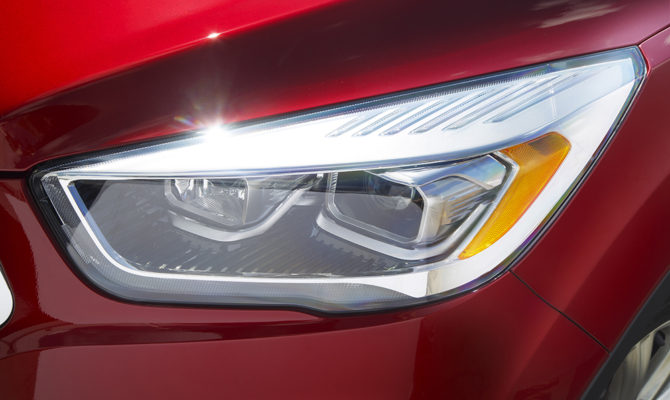Despite the ugly weather, the 2017 Ford Escape had much to distract yours truly in the way of technology and driveability.
Jasper, Alberta – The invite to take the 2017 Ford Escape on a 230-kilometre springtime jaunt along Icefields Parkway was irresistible.
Towering majestic mountains, glistening glaciers and possible roadside grizzly encounters – the latter viewed from the safety of Ford’s top-selling crossover – was a tempting way to put a welcome end to a dingy winter.
If your correspondent had joined the first wave of journos from across the country to do the drive, today you would be viewing shots of all the aforementioned natural beauty among pictures of a gleaming Escape and reading words rhapsodizing the glorious route across breathtaking terrain. Instead, the forecast for this review features scattered showers, hail, sleet and a lot of snow.
Despite the ugly weather, the 2017 Ford Escape had much to distract yours truly in the way of technology and driveability. Crossovers are hot in the Great White North (sorry, that was irresistible). The Ford folks told us in the pre-drive briefing that more than 700,000 Canadians bought crossover-style vehicles last year.
What’s more, these vehicles that mimic sport utility vehicles to a degree and provide the comfort of the trusty old family sedan now account for around one third of all sales in North America. The landscape has change dramatically since the first Escape appeared at the turn of the millennium in 2001.
Then there was little competition but now there are more than 20 vying for the attention of buyers. Moreover, expect many more to debut during the next few years as some manufacturers are convinced they are the future from which there will be no return to the past. In fact, some are bravely predicting sedans will be dramatically reduced by some manufacturer lineups.










The Escape has been merely refreshed in its appearance for 2017 but its myriad improvements under the skin are what make it worthy of closer analysis. The visual refresh includes the introduction of an aluminum hood and a front that now more closely resembles the lines of its larger crossover siblings. The tailgate is reshaped and features rear LED lights.
The cabin is much improved in fit-and-finish and the seating more adjustable and comfortable on a journey. The removal of the handbrake and its replacement by an electronic push button parking brake makes for more space up front.
Today, people are very enamoured with technology and this is an area that Ford have paid significant attention. Sync 3 Connect is standard on the Titanium trim and an optional tech package ingredient on the SE. It features Apple CarPlay/Android Auto and a Fordpass App that lets your smartphone use an onboard modem to check gas tank levels, start the engine and secure the vehicle remotely, to name but a few attributes.
Changes are evident under the hood. The 2.5-litre four-cylinder engine remains the base engine but two brand new turbocharged EcoBoost engines are now available, one is a 1.5-litre, 170 horsepower powerplant and the second a twin-scroll turbocharged 2.0-litre four-cylinder, which pumps out 245 horses.
Each new engine has auto start/stop, which Ford says improves fuel economy by up to six percent of the predecessor engines. When this technology was introduced a few short years ago this observer was a skeptic but careful monitoring in a variety of different manufacturers’ similarly equipped products show promises of better fuel economy are not idle boasts.
Frankly, they were also clunky in operation at first but are now dramatically smoother. The three engines are all matched to the same six-speed auto tranny and paddle shifters are available on the top-end models.
The Escape will not turn owners into off roaders overnight, nor should drivers think they could scale tall mountains. The all-wheel drive configuration will, however, cope wonderfully with most of what Canadian winters can throw at us on our highways.
Only the higher level trims were available on the launch but we should get access to the based model later this summer. The 2.0-litre engine was very responsive, smooth running and quiet.
The AWD version consumes gas at the rate of 11.5/8.7 L/100 km (city/hwy). The 1.5-litre version is probably better suited to the city dweller. Not surprisingly, less responsive but delivers a level of performance that will satisfy most folks. Fuel consumption is rated at 10.7/8.3 L/100 (city/hwy).
The base, front-wheel-drive Escape S starts at $25,099, the FWD SE costs $27,599, add AWD and it jumps to $29,799. The FWD Titanium is $33,799, and the AWD, $35,999.
Recent Comments
- { Enjoyed your Forest of Bowland in the BMW X5M, particularly the photo of the BMW in front of the main part of Stonyhurst College where... }
- { Bantam designed the Jeep, not Willy's or Ford. The American military gave the original Bantam prototype to Willys and Ford to copy. There is plenty... }
- { All Escalades come with a 6.2-lilter V8 engine that produces 420 horsepower. A six-speed automatic is the only transmission offered and drives the rear wheels.... }
- { Alexandra is an excellent journalist. }
Popular Posts
- Journey to a ‘Sparkling’ Luxury Okanagan Resort “Four lucky readers will put a Dodge Journey’s weekend-...
- The Need For Speed: Hike Those Highway Limits More than half of those polled believe the province sho...
- Drives-U-Crazy… Erratic drivers. An early morning drive from Kelowna to Vancouver is nor...
- Readers Respond: The Pros and Cons of Increasing B.C. Speed Limits Increasing the speed limits will only increase risk to...
- Honda CR-V Review: The Compact Crossover To Get Things Done The CRV is a very stylish and aerodynamic crossover veh...






